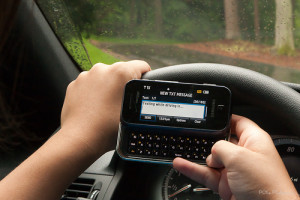There is increasing concern about the risk associated with distracted driving and more specifically with the manipulation of cell/smartphones while driving. Adolescents are a population at high risk given that approximately 50% of youth age 16 and older (U.S. data) admits texting/e-mailing while driving in the past-month.
A recent study by Klauer et al., Distracted Driving and Risk of Road Crashes among Novice and Experienced Drivers, shows how performing secondary tasks while driving increases the risk of crashing. Particularly among novice adolescent drivers (aged 16), the odds of crashing or nearly crashing greatly increased if drivers were sending or receiving text messages, reaching for a cell phone or dialing a cell phone (four, seven and eightfold risk increments, respectively). Other secondary tasks, such as reaching for another object other than cell phone, looking at roadside object and eating, were also associated with greater risk of crashing. The authors also found that, among novice adolescent drivers, the proportion of distracted driving tasks increased over time, suggesting that as drivers become confident in their driving they may relax their attitudes towards multitasking.
Reducing the prevalence of distracted driving surely requires a continuous effort from multiple organizations but also the engagement of active community members. In this regard, the U.S. department of transportation in April 2015 launched the National Driving Awareness Month, an initiative aiming at increasing awareness and promoting stronger regulations and enforcement programs. This effort also incorporated a specific component targeting adolescents that provided videos and reports on the risk associated with texting and driving, stories of teens involved in texting and driving events, tips to reduce the risk, and information on the changes in state regulations.
State texting laws targeting teens have been previously associated with an 11% decrease in traffic fatalities among adolescents. It is expected that the new efforts targeting multiple components will also translate in an important shift towards reduction in the acceptability of multitasking while driving, and in consequence on the prevalence of this behavior and the rate of injuries related to it.
*Helpful comments from Andres Villaveces
